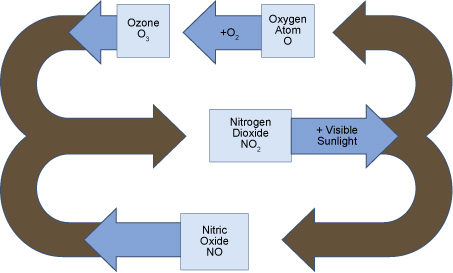|

DISCUSS OZONE AS IT RELATES TO AIR POLLUTION.AtmosphereAs you know, the oxygen found in the atmosphere is critical to the survival of all animal life, including humans. Even people in exceptionally good shape cannot hold their breath for more than a few minutes. If something happened to remove all the oxygen from the atmosphere, we would all die within minutes. This means that oxygen is a critical resource. Fortunately, using oxygen does not destroy it. It just gets recycled to be used over and over again. The bad news is that we can contaminate the atmosphere, making it hard for us to get clean oxygen to breathe. In this portion of the lesson you will learn more about this important resource and how it is affected by human activities. Please read the following information provided by the United States National Institute of Environmental Sciences. Ozone alertsOzone is a special form of oxygen. Like ordinary oxygen, ozone is one of the many gases in the air we breathe. Also like oxygen, ozone is made up of oxygen molecules. But while the molecules of ordinary oxygen are made up of two chemically linked oxygen atoms, the molecules of ozone are made of three such atoms. With its third atom of oxygen, ozone is not very stable—that is, it ordinarily does not last very long. A little ozone occurs naturally. An energy source such as lightning can produce it by temporarily breaking up pairs of oxygen atoms and reforming them as chemically linked clusters of three oxygen atoms (ozone). People, animals, and plants tolerate such naturally occurring, short-lived ozone pretty well. But when ozone builds up—generally as a result of our use of fossil fuels—it reacts very strongly with animal and plant tissues and even damages tough materials such as rubber, plastics, and outdoor paints.
You have probably seen hydrogen peroxide fizz, and perhaps you have felt it burn or “smart” your gums or skin tissues. Like ozone, hydrogen peroxide is closely related to a very stable molecule: water, or H2O. With an added oxygen atom, it changes to H2O2, becoming very reactive. The fizz and burn of hydrogen peroxide on a scratch or wound illustrate how, at high concentrations, ozone's own strong reactivity can irritate and damage the sensitive tissues of your eyes, lungs, nose, sinuses, and throat, causing burning eyes, shortness of breath, chest tightness, wheezing, coughing, and nausea. The sustained, higher levels of ozone that cause these effects usually begin with human activity. This means that when we use electricity for our lights, computer, and TV, when we heat our houses and run our cars and SUVs, or even when we roast chestnuts on an open fire or grill a steak, we often burn fossil fuels—hydrocarbons such as gasoline, heating oil, firewood, charcoal, and the coal for power plants. The combustion of these fuels releases oxides of nitrogen, which are gaseous combinations of oxygen and nitrogen (nitrogen being another common gas in our atmosphere). One of these combinations is nitrogen dioxide (NO2). When NO2 absorbs energy from sunlight, it breaks down to nitric oxide (NO) and a free oxygen atom. The free oxygen atom then barges into the oxygen pair to form the linked triplet of ozone (O3).  
|
About Us | Terms of Use | Contact Us | Partner with Us | Press Release | Sitemap | Disclaimer | Privacy Policy
©1999-2011 OpenLearningWorld . com - All Rights Reserved


